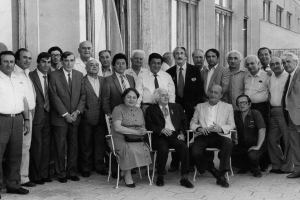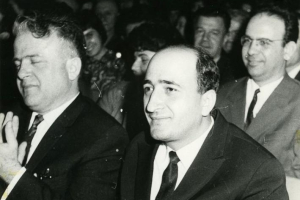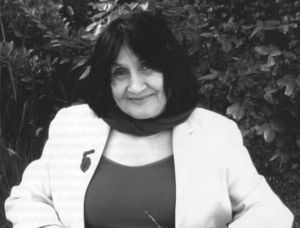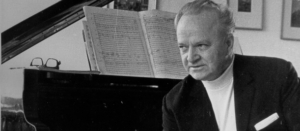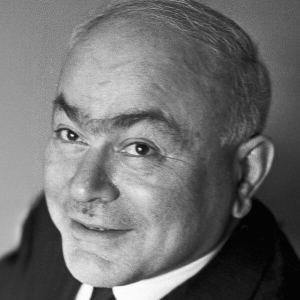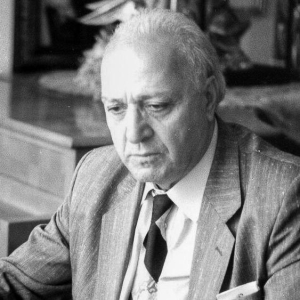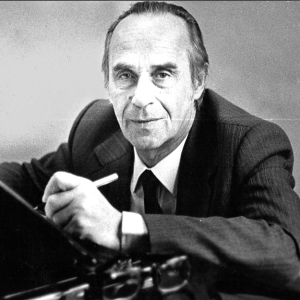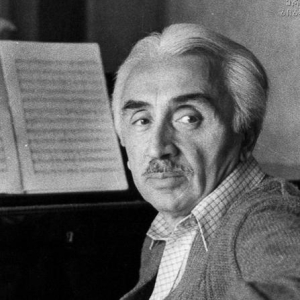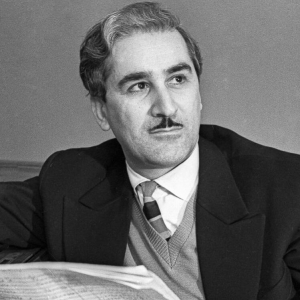Nodar
Mamisashvili
Nodar Mamisashvili
(1930 – 2022)
Nodar Mamisashvili – composer, teacher, inventor, theoretician-researcher, one of the prominent representatives of the Georgian generation of 60s. At the same time, the vice-president of the National Academy, member-correspondent of the Engineering Academy. His merits are outstanding not only in terms of compositional creativity, but also in the fact that he brought up more than one representative of the latest Georgian compositional school. Honored Worker of Georgian Art, Member of the Union of Composers…
Date of birth – December 15, 1930
Place of birth – Tbilisi, Georgia
Date of death – January 10, 2022
Place of death – Tbilisi, Georgia
BIOGRAPHICAL DATA
1956 – Graduated from the Tbilisi State Conservatory named after Vano Sarajishvili, majoring in composition (Andria Balanchivadze’s class);
1955 – 1963 – Teacher of music theory and composition at the N 3 music school;
1963 – 1972 – Teacher of music theory and composition at the No. 1 music school;
1962 – 1977 – Teacher, docent of the Department of Music Theory and Composition of the Tbilisi State Conservatory;
1973 – Dean of orchestral faculty of Tbilisi State Conservatory;
1977 – Professor of Tbilisi State Conservatory;
1967 – 1972 – Head of the Music Division of the Ministry of Culture of Georgia;
1976 – Artistic director of musical programs of Georgian radio and television;
1995 – President of Polo Studio “White Square”;
1996 – Main coordinator of the center of sound ecology;
1989 – Teacher of pre-history and history of Orthodox chanting at the Theological Academy;
He is the author of musical works: “Bakhia Bachia” (children’s opera), “Seven symphonies”, 4 piano concerts, choral oratorios and cycles, pieces for orchestra, organ, piano, etc. He has composed music for plays and films, not a single scientific paper…
Nodar Mamisashvili was the first in the world to create an acoustic scheme of resonance distribution of 9 church bells, according to which bells were distributed in the bell tower space in the Holy Trinity Cathedral.
AWARDS AND RECOGNITION
1959 – Member of the Union of Composers of the USSR
1967 – Honored Art Worker of Georgia
1973 – Secretary of the Board of the Union of Composers of Georgia
Nodar Mamisashvili
(1930 – 2022)
SELECTED WORKS
MUSIC FOR THE THEATER
1967 – “Bakhia Bachia” – Children’s Opera in 2 Acts
1963 – “Three Keys” – Ballet in 2 Acts
ORCHESTRAL MUSIC
1985 – Symphony No. 1 – “Dream”
1986 – Symphony No. 2 – “Man, Give Us Peace”
1989 – Symphony No. 3 – “Testimonies of Eternal Eternity”
1990 – Symphony No. 4 – “Spectres”
1990 – Symphony No. 5 – “Triptych”
1993 – Symphony No. 6 – “Sons of Cain”
1977 – Symphony for Large Symphonic Orchestra, Mixed Choir, Children’s Choir and Tape Recorder
1956 – “Tales” – Symphonic Fantasy
1959 – “Ice Obelisk” – Symphonic Picture
1961 – “Guria” (“Watercolors”) – Symphonic Suite
1963 – “Three Keys” – Symphonic Suite Based On The Ballet “Three Keys”.
1966 – Symphonic Sketches
1971 – 2 Pieces for Symphony Orchestra
1972 – “Celebratory Overture” – for Symphony Orchestra
1976 – “Singing Valley” – Symphonic Picture
1961 – Small Suite for Chamber Orchestra
1971 – 3 Pieces for Chamber Orchestra
1977 – Symphony N 2 – for Chamber Orchestra
1955 – Fantasy for Piano and Symphony Orchestra
1964 – “Pioneering” – Concerto for Piano and Chamber Orchestra
1973 – Concerto for Piano and Chamber Orchestra No. 2
1961 – Concerto for Oboe and Symphony Orchestra
1962 – Concerto for Trumpet and Symphony Orchestra
1967 – Concertino for Violin and Symphony Orchestra
1979 – Concerto for Piano, Woodwinds and Chamber Orchestra
CHAMBER-INSTRUMENTAL MUSIC
1964 – 6 Miniatures for String Quartet
1972 – Concertino for Piano Quintet
1958 – 24 Preludes for Piano
1961 – Ballad – for Piano
1962 – 2 Pieces for Violin and Piano
1963 3 Pieces for Harpsichord
1964 – Prelude, Chorale and Fugue for Piano
1965 – 3 Pieces for Cello and Piano
1966 – 3 Pieces for Harp
1967 – Chorale for Organ
1979 – “Lyric Diary Pages” – Piano Cycle
1979 – “Scherzo Barbaro” – for Piano
1980 – “Sad Triptych” – Piano Cycle
VOCAL MUSIC
1959 – 9 Moods – for Choir a Cappella
1968 – 3 songs – for Children’s Choir a Cappella – (text – A. Kalandadze, folk)
FILM AND THEATER MUSIC
MUSIC FOR RADIO SHOWS:
1956 – “Rabbit”
1957 – “Adventure of Nodar”
AUTHOR OF MUSIC FOR ABOUT 40 DRAMATIC PLAYS. BETWEEN THEM:
“Skapen’s Paintings”, “Living Portrait”, “Nana in the forest”, “Nettle”, “Gandegili”
FILMOGRAPHY
1960 – “Fast Train” – director – Nana Mchedlidze
1964 – “Agmafrena” – director – Nana Mchedlidze
1964 – “On the Road” – director – Nana Mchedlidze
1967 – “Big Green Field” – director – Merab Kokochashvili
1968 – “Color Change” – director – Lana Ghoghoberidze
1969 – “Grandmothers and Grandchildren” – director – Nana Mchedlidze
1971 – “Zoya Rukhadze” – director – David Rondel
1971 – “Fifteenth Summer” – director – Soso Chkhaidze
1976 – “Peak” – director – Merab Kokochashvili
1977 – “When mothers are not at home” – director – Pavle Charkvian
1978 – “The Green Island of Hope” – director – Omar Gvasalia
1981 – “Three days of hot summer” – director – Merab Kokochashvili
1981 – “Seven small stories about love” – director – Giorgi Mataradze
1987 – “Hey, Maestro!” – director – Nodar Managadze
2003 – “Variation on the theme of “Othello”” – director – Merab Kokochashvili
2005 – “Usui” – director – Merab Kokochashvili
ANIMATION
1958 – “Onavari” – director – Carlo Sulakauri
1976 – “Kvasanaki” – director – Ioseb Samsonadze, Bondo Shoshitaishvili
1977 – “Buzhzuna” – director – Otar Andronikashvili
1978 – “Eka and Tikan” – director – Otar Andronikashvili
1979 – “Devil’s Games” – director – Ioseb Samsonadze
1980 – “Dry beech” – director – Ioseb Samsonadze
1982 – “Behemoth and Dream” – director – Ioseb Samsonadze
1982 – “Roe and Meysre” – director – Giorgi Kasradze
1983 – “The bird will fly away” – director – Ioseb Samsonadze
1980 – “Kursha Gakoochda” – director – Gabriel Lavrelashvili
1987 – “Kerketi Kakali” – director – Ioseb Samsonadze
1991 – “Witness” – director – Bondo Shoshitaishvili
DOCUMENTARY
1981 – “The Road” – director – Merab Kokochashvili
2007 – “Georgian Mamluks in Egypt” – director – Merab Kokochashvili
2011 – “Cradle of Wine” – director – Merab Kokochashvili
SCIENTIFIC PUBLICATIONS
“About the musical system of three-phase composition” – Publishing House “Khelovneba”, Tbilisi – 1978
Nodar Mamisashvili
(1930 – 2022)
Nodar Mamisashvili’s name invokes many associations today: composer, inventor (author of 49 inventions), scientist whose interests and research topics include astrology, cosmology, philosophy, psychology, physics, chemistry, geology, metallurgy, architecture… the list can be continued…
Today, it is generally known that Nodar Mamisashvili, as a composer and artist, was not given full arena for the realization of his creative and scientific ideas, and as a result, he is unknown to the general audience.
The composer’s name was first heard by the classical music-loving Georgian audience in the 1950s, when two of his works were performed: a scherzo for flute and a trio for voice, violin, and “arranged” piano. The latter was inspired by avant-garde music. One of the first products of the composer’s research into musical language, timbral sound, and shape.
Here begins the composer’s fascination for 20th-century music innovations. Information about which was difficult to get for a musician living in the Soviet Union at the time. Since the 1960s, when a new phase in Georgian culture began, Georgian artists have been liberated from self- imposed limits, and conditions for receiving information have been created, and Nodar Mamisashvili has found himself in the path of his interests. His interests included Arnold Schoenberg’s 12-tone dodecaphonic, atonal system, Olivier Messiaen’s “limited transposition” concept, and Pierre Boulez’s “integral serialism.” Mamisashvili develops his own system, which begins with the national kilo-intonation, under the influence of Schoenberg’s dodecaphony. It is worth mentioning that Mamisashvili composes works that combine tonal and atonal music at this time period. Three pieces for chamber orchestra, as well as compositions for viola and cello, were written using this method.
Among the works created during this period of time, symphonic sketches such as “Blue Dancing Women” and “Impressions” brought attention. These pieces evoked impressionist music’s association with the presentation of brief experiences, refined harmony, and texture. “The Impressionist style opened up new musical vistas,” the composer says, “and I grasped that opportunity with great enthusiasm.” Another compositional idea, “constructive sound play,” has come to the forefront in Mamisashvili’s work since the 1970s. Piano concertino for quintet is one embodiment of this. This composition was first played on November 21, 1973, at the Tbilisi Conservatory’s recital hall during the opening evening of avant-garde music. The quintet had a great impression on the audience, despite the fact that radical, negative emotions did not decrease. According to musicologist Nana Loria, “for the first time in Georgian musical realm, a composition was heard in which a strict numerical calculation was coupled to random and the performer’s free choice.” The constituent parts of the piano quintet-concert piece switched places adlibatum style, although the form retained it’s crystalline nature and inspired associations with a musical Rubik’s cube. This composition was also played in Dubno at that time, attracting the attention of young musicians and scientists.
The production of Nodar Mamisashvili’s children’s opera “Baqia Bachia” in the 1970s was a significant moment in Georgian cultural life.
“Bakhia Bachia” attracted the audience in with its unusual dramaturgical solution and the players’ lively, impressive personalities. The opera’s musical language was built on a synthesis of modern avant-garde and national music. There was also a mixture of tonal and atonal concepts here. The composer’s national origin merged several discoveries. Unfortunately, The only complete manuscript of “Baqia Bachia” was destroyed during the fire, of Tbilisi Opera House. Mamisashvili’s creative life was constantly defined by searches and discoveries. His interest in the subject of sound framework patterns in twentieth-century music led to the development of a three-phase compositional system. The composer theoretically created the “three-phase composing system,” which was published in (1978).
The “three-phase system’s” main force is acoustic, vertical perception, and structural synthesis. As one of the bases, the author used unique aspect of national folklore – the principle of Georgian polyphony. Mamisashvili’s creativity developed both rational, technical thinking and spiritual- mystical sensations. His creative and scientific studies are linked by a desire to understand the origins of the cosmos, humans, and eternal life. One can sense a desire towards the cosmic imagination of the world in the works of the 1980s; here, there is a symbiosis in the form of a sense of poetic mystery and rational thinking – a three-phase system. And it is not surprising that composer Eka Chabashvili used the term “astral romanticism” to describe this musical-artistic approach. Compositions in this style include, Symphony No. 5 for tape recorders, 3 pianos, tenor and soprano, Symphony No. 6 “Sons of Cain,” Symphony No. 7 – electronic “Cain in Space”, “Demon” poem for Harprichord, etc.
Because of technical difficulties, the performance of these compositions, are not known to the public. In contrary – the cycle of piano works known as “Lyric diary pages” gained popularity. The cycle, in which the author’s own vision is represented by the symbols of compositional thinking of various twentieth-century movements, as well as the textural-polyphonic principles of national folklore. The cycle’s final play, “Schertso-Barbaro,” was made an essential work in the repertoire of the Tbilisi International Piano Competition in 2003. The composer’s cello concert “Time of the Heart,” which was played at the “Music in Cosmos” festival in Switzerland in 2006, was highly appreciated.
In this period of time, Nodar Mamisashvili developed a variety spectrum of three-phase compositions, which he referred to as the unifying system of numerous sorts – Holo-system, holophony. Special performance conditions are required for works written in Holo-system. For this reason Mamisashvili also created the “Holo studio” project. The composer has composed in Holo-system for the majority of his pieces over the past few decades. Thesis papers were published regarding Mamisashvili’s Holo-system in Tashkent and Yerevan, and his student, composer Marina Adamia, presented it at an Edinburgh competition and gained success.
Nodar Mamisashvili composed music for plays, films, and animated pictures. He wrote songs based on his own poetry. Mamisashvili’s poetry pieces have lately been more widely known., which the author has linked with music and the so-called three-phase system: “Lyrics are the most closely related to my music. Three-phase composing system’s main components contradict the usual norms of splitting from series to phrases. The search for the appropriate pulsation stimulated my interest in the poem’s rhythmic structure and form, and thus poetic creativity became an essential part of compositional innovation.”
The harmonic placement of Georgian bells and the creation of the cathedral’s acoustic signal are two of Nodar Mamisashvili’s most significant achievements. His design is used to manufacture the bells of Tbilisi’s Trinity and Makhata Cathedrals. This was the result of his research into the relationship between Georgian hymn sounds and chimes. These explorations were represented in his compositions, such as the a cappella choral cycles “da ganantla kideni soplisani” (dedicated to Ilia Chavchavadze, 1986) and “Gantzdani, dausabamosa mzisa” (1980).
“I believe that every person is born with a national purpose, whether consciously or unconsciously,” said Nodar Mamisashvili, whose works demonstrate the variety and depth of his mission, which is to be studied in the future.
Musicologist
Tamar Tsulukidze
English Language Translator
Tamar Kharadze












